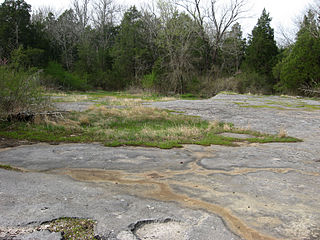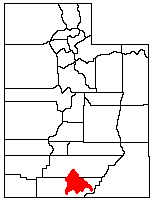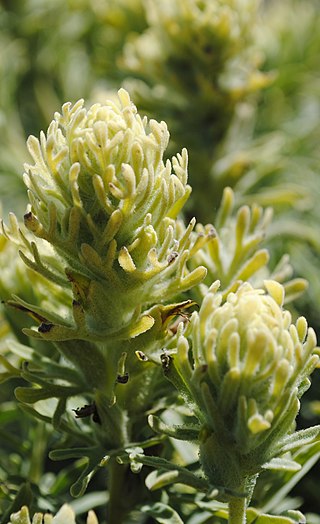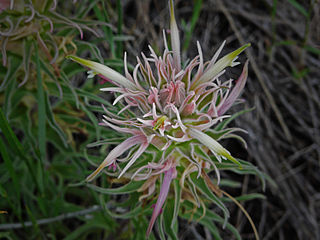
Castilleja, commonly known as paintbrush, Indian paintbrush, or prairie-fire, is a genus of about 200 species of annual and perennial herbaceous plants native to the west of the Americas from Alaska south to the Andes, northern Asia, and one species as far west as the Kola Peninsula in northwestern Russia. These plants are classified in the broomrape family Orobanchaceae. They are hemiparasitic on the roots of grasses and forbs. The generic name honors Spanish botanist Domingo Castillejo.

Castilleja indivisa, commonly known as Texas Indian paintbrush or entireleaf Indian paintbrush, is a hemiparasitic annual wildflower native to Texas, Louisiana, and Oklahoma in the United States. There are historical records of the species formerly growing in Arkansas, and reports of naturalized populations in Florida and Alabama.

A calcareous glade is a type of ecological community that is found in the central Eastern United States. Calcareous glades occur where bedrock such as limestone occurs near or at the surface, and have very shallow and little soil development. Due to the shallow soil and the extreme conditions created by it, trees are often unable to grow in the glades. This creates a habitat that is usually sunny, dry, and hot. Calcareous glade vegetation is more similar to that of a desert habitat than a grassland, being dominated by small spring annuals with occasional geophytic or succulent perennials.

The Tiburon paintbrush or Tiburon Indian paintbrush is an endangered taxon of flowering plant in the family Orobanchaceae. It is endemic to the San Francisco Bay Area in California in the United States, where it occurs in Marin, Napa, and Santa Clara Counties.

Castilleja applegatei is a species of Castilleja known by the common names Applegate's Indian paintbrush and wavyleaf Indian paintbrush.

Castilleja exserta is a species of plant in the genus Castilleja which includes the Indian paintbrushes. Its common names include purple owl's clover, escobita, and exserted Indian paintbrush.

The Kaiparowits Plateau is a large, elevated landform located in southern Utah, in the southwestern United States. Along with the Grand Staircase and the Canyons of the Escalante, it makes up a significant portion of the Grand Staircase–Escalante National Monument. Its extension to the southeast, Fiftymile Mountain, runs nearly to the Colorado River and Lake Powell, and is a prominent part of the northern skyline from the Glen Canyon National Recreation Area.

Castilleja linariifolia is a perennial plant, native to the United States and is the state flower of Wyoming. It has a number of common names including Wyoming Indian paintbrush, narrow-leaved Indian paintbrush, desert paintbrush, Wyoming desert paintbrush, Wyoming paintbrush, linaria-leaved Indian Paintbrush, and Indian paintbrush.

Castilleja grisea is a rare species of Indian paintbrush known by the common name San Clemente Island Indian paintbrush. It is endemic to San Clemente Island, one of the Channel Islands of California. San Clemente Island is owned by the US Navy so the Navy is involved in a management program to recover this species.

Castilleja pilosa is a species of Indian paintbrush known by the common name parrothead Indian paintbrush. It is native to the western United States from California to Wyoming, where it grows in mountain and plateau habitat across the Great Basin and surrounding regions. It is known from sagebrush scrub to high mountains in alpine climates.

Castilleja levisecta is a rare species of flowering plant in the family Orobanchaceae known by the common name golden paintbrush, or golden Indian paintbrush, listed under the Endangered Species Act in 1997. It is native to British Columbia and Washington, where it is known from eleven remaining populations. It occurred in Oregon but all natural occurrences there have been extirpated. It has been reintroduced to a few areas in Oregon, but it remains to be seen if the plants will survive. The plant is a federally listed endangered species of Canada and was listed as threatened in the United States in 1997. On June 30, 2021, the plant was proposed for delisting due to recovery. Effective August 18, 2023, the U.S. Fish and Wildlife Service issued a rule removing golden paintbrush from the Federal List of Endangered and Threatened Plants

Castilleja septentrionalis is a species of Indian paintbrush known by several common names, including northern paintbrush, sulfur paintbrush, and pale painted cup. There is taxonomic disagreement as to if it is one species widely distributed in mountain and alpine environments of North America or if there is a second species, Castilleja sulphurea, in the Rocky Mountains.

Castilleja christii is a rare species of flowering plant in the family Orobanchaceae known by the common name Christ's Indian paintbrush. It is endemic to Idaho in the United States, where there is a single population on Mount Harrison in the Albion Mountains in the Minidoka Ranger District of Sawtooth National Forest. It is one of Idaho's rarest plants.
Potentilla angelliae is a rare species of flowering plant in the rose family known by the common names Angell cinquefoil and Boulder Mountain cinquefoil. It is endemic to Utah in the United States, where it is known only from Boulder Mountain on the Aquarius Plateau.

Castilleja sessiliflora is a species of flowering plant in the family Orobanchaceae known by the common names downy Indian paintbrush and downy paintedcup. It is native to the Great Plains of North America from southern Canada, through the central United States, to northern Mexico. It occurs as far west as the eastern slopes of the Rocky Mountains.

Castilleja kaibabensis is a species of flowering plant in the family Orobanchaceae known by the common name Kaibab Plateau Indian paintbrush. It is endemic to the Kaibab Plateau of Coconino County, Arizona, in the United States.
Castilleja salsuginosa is a species of flowering plant in the family Orobanchaceae known by the common name Monte Neva Indian paintbrush. It is endemic to Nevada in the United States, where it is known from two populations, one in White Pine County and another in Eureka County. The two occurrences of this plant are located about 83 miles (134 km) apart within the Great Basin. There are only about 275 individuals.

Castilleja integra, with the common names orange paintbrush, Southwestern paintbrush, and wholeleaf paintbrush, is a partially parasitic herbaceous perennial plant native to the Southwestern United States and Northern Mexico. The species produces a relatively large amount of nectar and is attractive to hummingbirds. It is better suited to cultivation than most other species in the paintbrush genus (Castilleja) and is therefor used in xeriscape gardens and naturalistic meadows, even outside its native range.
Castilleja kerryana is a species of flowering plant in the family Orobanchaceae. It is commonly known as Kerry's Indian paintbrush or Kerry’spaintbrush. It was formally described in 2013 and so far it is known only from a small population in the state of Montana, in the Northwestern United States.

Castilleja bella is a species in the Castilleja genus known by the common name Arteaga Indian paintbrush. It is native to northeastern Mexico, primarily the states of Nuevo León and Coahuila, where it grows in montane habitats.

















